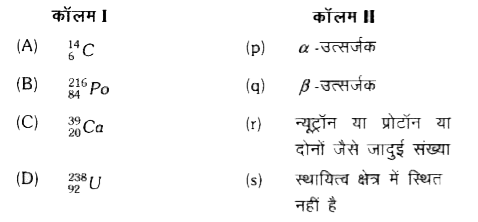In each of the following questions, statements are given in two columns, which have to be matched. The statements in Column I are labelled as (A), (B), (C) and (D), while those in Column II are labelled as (P), (Q), (R), (S) and (T). Any given statement in Column I can have correct matching with one or more statements in Column II.
Match the radical with the change observed on qualitative analysis

(A) - (R)
(B)- (S)
(C)- (Q), (S)
(D) -(P)
Similar Questions
Match the statements in Column I labeled as (a), (b), (c), and (d) with those in Column II labeled as (p), (q), (r), and (s). Any given statement in Column I can have correct matching with one or more statements in Column II.

View SolutionMatch the statements in Column I labelled as a,b,c, and d with those in Column II labelled as p,q,r, and s. Any given statement in column I can have correct matching with one or more statements in Column II
View Solutionइस खण्ड में कुछ प्रश्न है। प्रत्येक प्रश्न में कॉलम-I में कुछ कथन (A, B, Cऔर D) और कॉलम-II में कुछ कथन (p, q,r, s और t) है। कॉलम-I का कोई भी कथन कॉलम-II के एक कथन या एक से अधिक कथनों से मेल खाता है। उदाहरण के लिए, दिए हुए प्रश्न में यदि कथन B कथनों q और r से मेल खाता है, तो ORS में उस प्रश्न के लिये कथन B के सामने q और r से संबंधित बुलबुलों को काला कीजिए।

कॉलम I में दी गई प्रविष्टियों को कॉलम II में दी गई प्रविष्टियों से सुमेलित कीजिए।

View Solutionइस खण्ड में कुछ प्रश्न है। प्रत्येक प्रश्न में कॉलम-I में कुछ कथन (A, B, Cऔर D) और कॉलम-II में कुछ कथन (p, q,r, s और t) है। कॉलम-I का कोई भी कथन कॉलम-II के एक कथन या एक से अधिक कथनों से मेल खाता है। उदाहरण के लिए, दिए हुए प्रश्न में यदि कथन B कथनों q और r से मेल खाता है, तो ORS में उस प्रश्न के लिये कथन B के सामने q और r से संबंधित बुलबुलों को काला कीजिए।

कॉलम I में दी गई प्रविष्टियों को कॉलम II में दी गई प्रविष्टियों से सुमेलित कीजिए।

View SolutionIn each of the following questions, statements are given in two columns, which have to be matched. The statements in Column I are labelled as (A), (B), (C) and (D), while those in Column II are labelled as (P), (Q), (R), (S) and (T). Any given statement in Column I can have correct matching with one or more statements in Column II. Match the reaction with the type of change.
View SolutionIn each of the following questions, statements are given in two columns, which have to be matched. The statements in Column I are labelled as (A), (B), (C) and (D), while those in Column II are labelled as (P), (Q), (R), (S) and (T). Any given statement in Column I can have correct matching with one or more statements in Column II. Match the radical with the associated change during analysis.
View SolutionIn each of the following questions, statements are given in two columns, which have to be matched. The statements in Column I are labelled as (A), (B), (C) and (D), while those in Column II are labelled as (P), (Q), (R), (S) and (T). Any given statement in Column I can have correct matching with one or more statements in Column II. Match the change observed during analysis of the radical.
View SolutionIn each of the following questions, statements are given in two columns, which have to be matched. The statements in Column I are labelled as (A), (B), (C) and (D), while those in Column II are labelled as (P), (Q), (R), (S) and (T). Any given statement in Column I can have correct matching with one or more statements in Column II.
Match the change observed during the analysis of the cation

View Solution
